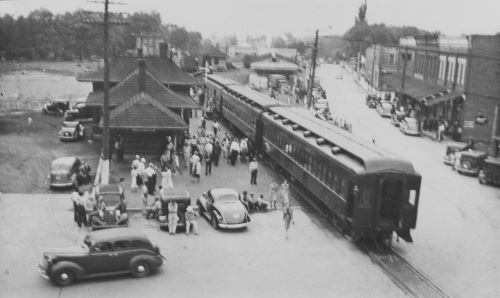History
From its beginnings over one hundred years ago, the Tennessee Central Railroad was a significant force in the development of Putnam County and Cookeville. It was a paramount feature in our political, cultural and social landscape. Though it ceased operations in 1968, its contribution to the fabric of our lives was kept alive by citizens that cared enough to resurrect a derelict old depot and help turn it into a museum dedicated to preserving an elemental part of our history.
Built in 1909, it replaced the Nashville & Knoxville two-story frame depot that was built in 1890. This depot is notable for being one of only three brick depots erected by the TC, and for its unusual pagoda style roof design. It was often referred to as the “Jewel” in TC’s crown. The building ceased being a passenger station in 1955, when the Tennessee Central Railroad eliminated its passenger service, but served other railroad uses until the TC went out of business in 1968. The building was in serious disrepair when a group of citizens took an interest in preserving it, and at their urging, the City of Cookeville purchased it from the L&N Railroad in 1975, and, along with the citizens group (which later became the Friends of the Depot), undertook its restoration. The Cookeville Tennessee Central Depot was placed on the Register of Historic Places in 1985 and became a museum at that time.
Rolling Stock
The Cookeville Depot Museum has four pieces of rolling stock on its grounds. These include a Tennessee Central Caboose, a 1913 Baldwin Steam Engine and two small track cars. The caboose is open during museum hours for you to step aboard, but remain closed during inclement weather.
The grounds surrounding the trains are considered a park area, and this area also offers two picnic tables and a number of benches for visitors, so feel free to bring a sack lunch and stay a while.

TC Caboose
This caboose was built around the same time as the Cookeville Depot building. It was acquired by the Friends of the Depot from the Leslie Bowman estate in Muddy Pond (near Monterey, TN). The caboose went through an extensive restoration when it was moved to the Depot grounds in 1993. It is typical of cabooses of the day in that it was not only the work center for the freight crew, but home as well. Meals were cooked on a coal stove which also provided heat in the winter. Tool lockers became crew bunks. The caboose, originally of all wood construction, later acquired a steel skin to help prolong its useful life. It is a Cupola Type caboose.
Cabooses became obsolete in the late 70’s to early 80’s, due to smaller crews, electronic monitoring, and computerization.
Track Cars
The Cookeville Depot Museum houses two small track cars, one green and one orange, which were used to move track workers from one point to another to repair or work on the tracks.

509 Steam Engine
The Louisiana and Arkansas RR acquired this “Ten Wheeler” directly from the builder, Baldwin Locomotive Works, in 1913. They took delivery of eleven 4-6-0’s that were used in both passenger and freight service. It was designated Engine Number 403 and later renumbered 509. It served the L&A until 1950, when it was sold to the Louisiana and Midland RR, which used it until a head on collision with their own “Mikado,” Engine 551, took it out of service. It was repaired by a private citizen and sold to the Tennessee Valley Railroad Museum in 1982, where the tender was re-lettered with the Louisiana & Arkansas designation. The 509 was acquired by the Friends of the Cookeville Depot Museum in 2002. It was reconfigured to match the large fleet of Baldwin 4-6-0’s operated by the Tennessee Central Railway Company. Its markings were changed accordingly and its numerical designation remained as 509, joining the ranks of its historical sisters- the TC500, 501, 502, 503, 504, 505, 506, and 507- all “Ten Wheelers” which regularly pulled their cargos past the Cookeville Depot.

